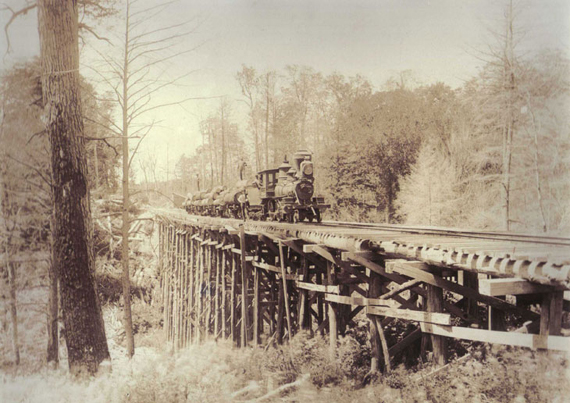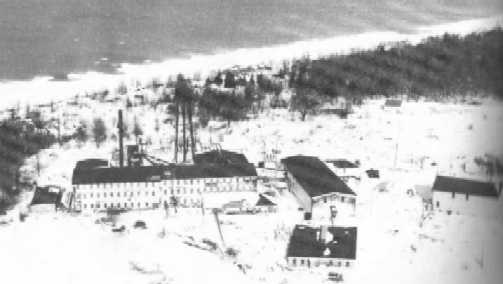Historic Site: The Evolving North End of Lake Arcadia
Based on the Remember When insert to the Manistee News Advocate. July 2017.
|
In recent months [in the Summer of 2017], the land at the north end of Lake Arcadia was cleared to prepare the grounds for the planned Swan Resort. Excavation revealed old pipes, rails, and other artifacts reminding us of the long history of that site. |
|
Its Story Began with Sam GilbertIn the 1860s when Sam Gilbert explored the area, he drew a map showing 40-50 acre Indian farms along the northeastern shore of what would be Lake Arcadia, but nothing yet along the northern shore. That land was part of the area he simply called “good land.”
|
|
Next Came Henry StarkeWhen marine contractor Henry Starke arrived in the 1870s, he saw the potential for millions of board feet of lumber, a small lake that could hold logs, and, with a channel through the narrow sand bar separating the lake from Lake Michigan, a safe harbor he could use for shipping his timber products to other settlements along the Lake Michigan shore. So he bought timber land and land in the area originally known as Starkieville. In 1880, he cleared the site at the north end of the lake and built a large sawmill. |
|
|
The Starke Land & Lumber Company (SL&LCo) used a narrow gauge railway to haul logs to the mill. It initially ran north from the sawmill and then east along what is Oak Street today, across what is M-22 today, and into forest land farther east. The railway’s route changed as needed to reach new stands of timber. Eventually it would use four trestles to cross deep ravines on its way to a settlement called Malcolm. |
|
|
Large trestles are costly to maintain, and the narrow gauge’s steep route east limited the railway to going uphill empty and coming back downhill carrying logs on a scary ride. In 1893, the conversion to standard gauge rails began, and a new flatter route was selected to avoid the need for expensive trestles and provide many more stops along the way to add farm produce and passengers to the railway’s mix of transported products. This new route with standard gauge rails and equipment became the Arcadia & Betsey River Railway (A&BRR). Making FurnitureLike many other lumbering towns, by the early 1900s, the SL&LCo was running out of trees. In 1906 when the sawmill burned down for at least the second time, the board decided to “sell it all:” the remainder of the buildings, equipment, timber land, everything. They sent a Mr. Donat out to find a buyer, but he met with representatives from the Fox & Mason Furniture Company, who convinced him and eventually the SL&LCo board to go into the furniture business instead. The Arcadia Furniture Company was born. They cleared the site at the north end of Lake Arcadia and built the company’s furniture factory. The Arcadia Furniture Company’s factory was a large facility with the three-story factory building, a mirror works, and eleven other structures covering the entire site and part of the area east of what is Lake Street today. Back then Lake Street ended at the sprawling furniture factory. |
|
|
The factory employed many Arcadians for nearly half a century before closing in 1953. The main factory building was used for a while after that as a turkey factory, but that too burned down in the late 1950s killing thousands of turkeys. More recently, the site was used as a campground, and the former Mirror and Glass Works building was used to provide shower and restroom facilities for campers. |
|
 |
|
So what can we learn from the site today?A few years ago if you looked closely, you might still have found a concrete block from the demolished Mirror Works. Like a number of other buildings in Arcadia, each block had a characteristic appearance based on the fact that each was made using the same kind of Sears & Roebuck block making machine. According to their catalog, “…one man could make from 100 to 150 perfect blocks per day…” Excavation of the site revealed buried standard gauge rail. The A&BRR had a station at the northeast corner of the factory with sidings and an engine house nearby. The rails ran from the factory showroom south along the northeast corner of Lake Arcadia before heading east out of town through the swamp. But what happened to the older narrow gauge rail? One answer: rebar! The furniture factory had a water tower sitting on four huge concrete blocks. When the blocks were crushed, narrow gauge rail was found inside being used as rebar to strengthen the blocks! We can’t wait to see what else is uncovered at sites around the Arcadia area. |
|
 Sam Gilbert's Arcadia Sketch
Sam Gilbert's Arcadia Sketch




 Water Tower Supports
Water Tower Supports